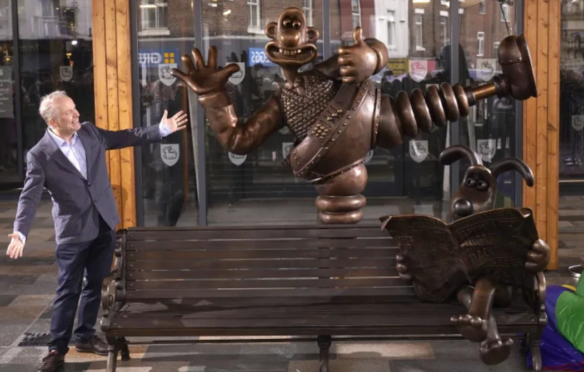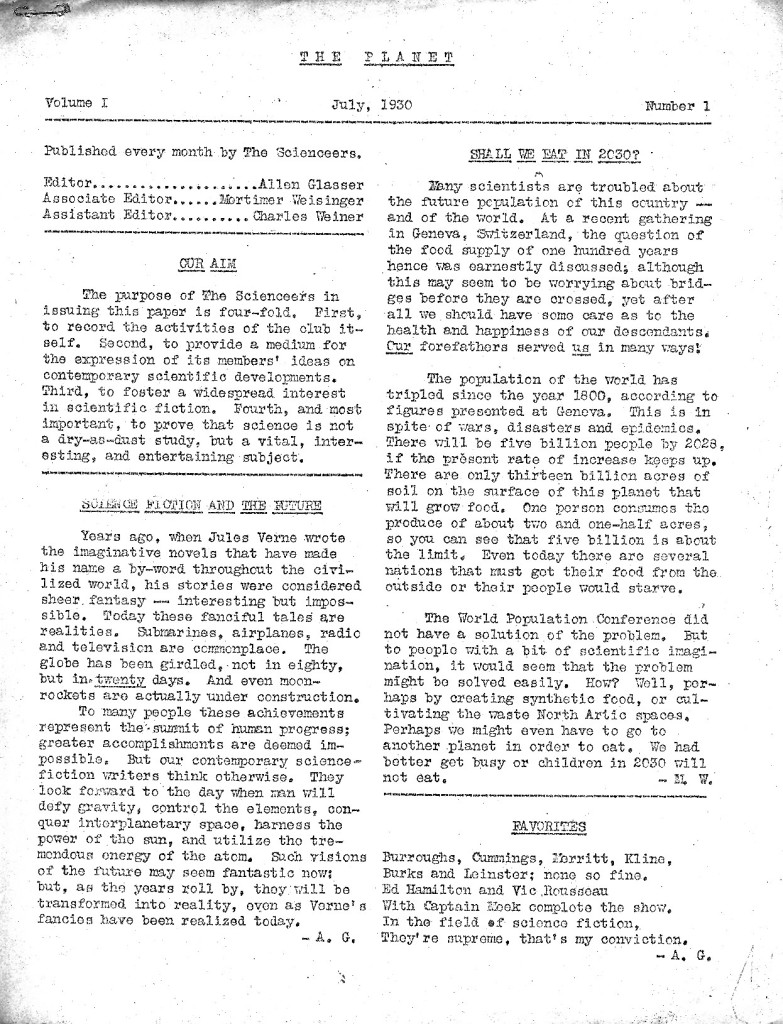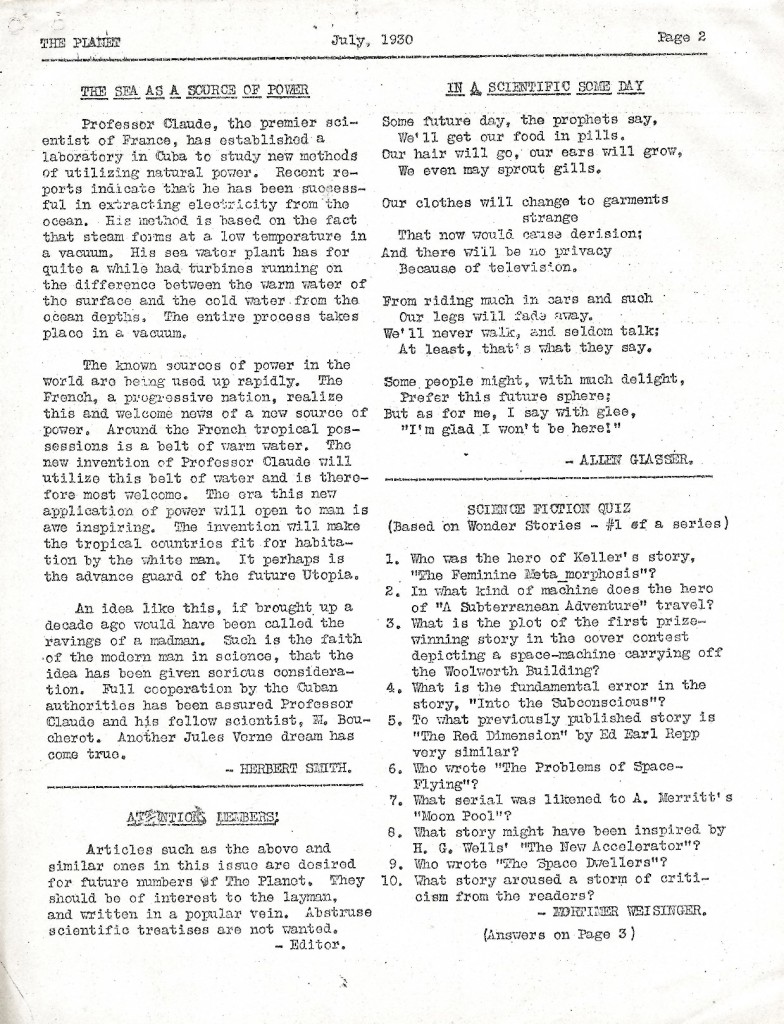(1) THE BRONZE TROUSERS. “’Cheese!’: Bronze statue of iconic duo Wallace and Gromit unveiled in Preston by creator Nick Park” reports ITV News Granada.

A large bronze statue of the iconic, cheese-loving duo Wallace and Gromit has been unveiled in Lancashire.
The bench sculpture is based on the inventor and his loyal pooch as they appeared in short-film ‘The Wrong Trousers’, and now sits pride of place outside Preston Markets.
(2) WORDSMITH. John Scalzi celebrates “30 Years of Being a Professional Writer” with a not-very- shocking admission:
…Thirty years on I do not have the writing career I thought I would have when I started out. I’ve said this before and I think people disbelieve me, but: I had no intention of being a novelist, or, at the very least, I assumed that if I were to write novels, that they would be a nice occasional side hustle. What I hoped for at the time — and what I assumed would be the case — is that I would write for newspapers all my life. The gig at the Fresno Bee would lead to gigs at other newspapers, and eventually I would land up at the New York Times/Washington Post/Los Angeles Times/Chicago Tribune as a daily columnist, riffing off local and world events like idols such as Mike Royko or Molly Ivins. Twenty-two-year-old me fully expected an entire career of daily deadlines and 800-word bursts of opinion.
And, I’m not going to lie, part of me is sad I didn’t get that life. Not too sad, because, well. Hello, welcome to Whatever, which I have been writing at for twenty-three years come Monday….
(3) NOUGHTS & CROSSES AUTHOR. Guardian reporter Sian Cain interviews YA SFF writer Malorie Blackman: “‘Hope is the spark’”.
…The last 18 months, however, have been a significant challenge. Having been classed as extremely vulnerable due to a health condition, Blackman has been isolating for most of the pandemic – and it is clear that, as she puts it, she “loves a chat”. “It has been a very strange time,” she says. “I was getting government letters saying: ‘Don’t go out.’ I was trying to live as normal a life as possible, knowing full well it was extraordinary circumstances. But you do what you can, so I focused on my writing. Endgame was a good thing because it felt like I was doing something. I wasn’t saving lives, but I was doing something.”
What she was doing is probably the hardest thing an author can do: writing the ending. After 20 years, six books and three novellas, Noughts & Crosses, Blackman’s most famous series, is finished. It is set in Albion, an alternative Britain that was colonised by Africa, where the black population call themselves Crosses (as they are closer to God), while the white are Noughts (poorer, institutionally discriminated against)….
(4) IT’S TIME TO BE SIMULTANEOUS. The good folks at Space Cowboy Books have released Simultaneous Times, Vol. 2.5, a free ebook anthology of stories featured at the Simultaneous Times podcast. One of them is by Cora Buhlert. Here is a book trailer for the anthology:
(5) KRUGMAN, PALMER & WALTON. CUNY will host “Imagining the Future: Economics and Science Fiction” on November 10 at 7:30 p.m. Eastern. Register for Zoom webinar access at the link.
What do economics and science fiction have in common? Much in the way economists forecast the results of social and economic structures, science-fiction writers envision future civilizations, both utopian and dystopian, through systematic world-building. Paul Krugman, distinguished professor of economics at the CUNY Graduate Center, joins in a conversation about the connection between the social sciences and fantasy fiction, and how they often inspire each other. Featuring: Ada Palmer, author of the Terra Ignota series and associate professor of history at the University of Chicago; Jo Walton, whose many books include Tooth and Claw, Ha’Penney, and the recent Or What You Will; and others.

(6) FRAMING TOOL. Maybe an algorithm will help make that blank screen less empty: “New tool could help authors bust writer’s block in novel-length works” reports Penn State News.
… Researchers at the Penn State College of Information Sciences and Technology recently introduced a new technology that forecasts the future development of an ongoing written story. In their approach, researchers first characterize the narrative world using over 1,000 different “semantic frames,” where each frame represents a cluster of concepts and related knowledge. A predictive algorithm then looks at the preceding story and predicts the semantic frames that might occur in the next 10, 100, or even 1,000 sentences in an ongoing story….
The researchers’ framework, called semantic frame forecast, breaks a long narrative down into a sequence of text blocks with each containing a fixed number of sentences. The frequency of the occurrence of each semantic frame is then calculated. Then, the text is converted to a vector — numerical data understood by a machine — where each dimension denotes the frequency of one frame. It is then computed to quantify the number of times a semantic frame appears and signifies its importance. Finally, the model inputs a fixed number of text blocks and predicts the semantic frame for the forthcoming block.
…Authors could use the tool by feeding a part of their already-written text into the system to generate a set of word clouds with suggested nouns, verbs and adjectives to inspire them when crafting the next part of their story.
(7) MEMORY LANE.
- 1979 – Forty-two years ago on this date, Wonder Woman put away her lasso for the last time as her series came to end after three seasons. The show’s first season aired under the name of Wonder Woman on ABC and is set in the 1940s, during World War II. The last two seasons aired on CBS and was set in the then-current day late Seventies, with the title changed to The New Adventures of Wonder Woman. It starred Lynda Carter as Wonder Woman / Diana Prince and Lyle Waggoner as Steve Trevor Sr. There would be fifty-nine episodes and a movie before it ended. Currently you can find it on HBO Max along with everything Wonder Woman that Warner Media has done. Audience reviewers at Rotten Tomatoes currently give it an excellent eighty percent rating.

(8) TODAY’S BIRTHDAYS.
[Compiled by Cat Eldridge.]
- Born September 11, 1934 — Ian Abercrombie. He played a most excellent and proper Alfred Pennyworth on the terribly well done Birds of Prey, a certain Professor Crumbs in Wizards of Waverly Place, he was Wiseman in Army of Darkness andvoiced Palpatine in Star Wars: The Clone Wars. (Died 2012.)
- Born September 11, 1940 — Brian De Palma, 81. Though not a lot of genre work, he has done some significant work including Carrie. Other films he’s done of interest to us are The Fury which most likely you’ve never heard of, and the first Mission: Impossible film along with Mission to Mars. Not genre, but I find it fascinating that he directed Bruce Springsteen’s Dancing in the Dark video which has a genre connection as actress Courtney Cox would be in the Misfits of Science series and the Scream horror franchise as well.
- Born September 11, 1941 — Kirby McCauley. Literary agent and editor who represented authors such as Stephen King, George R.R. Martin and Roger Zelazny. And McCauley chaired the first World Fantasy Convention, an event he conceived with T. E. D. Klein and several others. As Editor, his works include Night Chills: Stories of Suspense, Frights, Frights 2, and Night Chills. (Died 2014.)
- Born September 11, 1948 — Michael Sacks, 73. He’s best remembered as Billy Pilgrim in Slaughterhouse Five. Given how short his film career was, as it lasted but little over a decade, that’s no surprise. His only other genre role was as Jeff in The Amityville Horror. He’s now in the financial services sector.
- Born September 11, 1951 — Michael Goodwin, 69. Ahhh, Alan Dean Foster’s Commonwealth series. I know that I’ve read at least a half dozen of the novels in that series and really enjoyed them, so it doesn’t surprise that someone wrote a guide to it which is how we have Goodwin’s (with the assistance of co-writer Robert Teague) A Guide to the Commonwealth: The Official Guide to Alan Dean Foster’s Humanx Commonwealth Universe. Unfortunately like so many of these guides, it was done once part way through the series and never updated.
- Born September 11, 1952 — Sharon Lee, 69. She is the co-author with Steve Miller of the Liaden universe novels and stories which are quite excellent reading with the latest being Neogenesis. They won Edward E. Smith Memorial Award for significant contribution to SF in the spirit of the writer E.E. “Doc” Smith, and they won The Golden Duck, the Hal Clement Young Adult Award, for their Balance of Trade novel. They are deeply stocked at the usual digital suspects.
- Born September 11, 1958 — Roxann Dawson, 63. Best remembered for being B’Elanna Torres on Voyager. She’s also a published genre author having written the Tenebrea trilogy with Daniel Graham. This space opera series is available from the usual digital suspects. She’s got two genre film creds, Angela Rooker in Darkman III: Die Darkman Die, and Elizabeth Summerlee in the 1998 version of The Lost World. She’s the voice of The Repair Station computer on the “Dead Stop” episode of Enterprise. Oh and she popped up once on the Seven Days series. She’s long since retired from acting.
- Born September 11, 1965 — Cat Sparks, 56. Winner of an astounding fourteen Ditmar Awards for writing, editing and artwork, her most recent was in 2019 when she garnered one for “The 21st Century Catastrophe: Hyper-capitalism and Severe Climate Change in Science Fiction.” She has just one published novel to date, Lotus Blue, though there’s an unpublished one, Effigy, listed at ISFDB. She has an amazing amount of short stories all of which are quite stellar. Lotus Blue and The Bride Price collection are both available at the usual digital suspects. (CE)
(9) NEAR TO THE MADDING CROWD. The DickHeads Podcast – so-called for their interest in Philip K. Dick – makes a side excursion to discuss someone who once gave an opinion about a PKD story: “Judith Merril Roundtable”.
Dick Adjacent is back. And it’s a good one too. The story goes that after David finished reading some of Judith Merril’s stories, he found a scathing review she wrote of PKD’s story Roog, and with that connection made, it seemed only appropriate to gather a panel of experts together and discuss her place in the science fiction universe. Considered a feminist force, she had to bully her way through a male-dominated business to make her voice heard. Incredible person. Incredible story. And a truly accredited panel. So listen in on David, Lisa Yazek, Gideon Marcus, Ritchie Calvin, and Kathryn Heffner as they discuss the legacy of Judith Merril.
(10) FLICKS BY THE BRIDGE. The Brooklyn SciFi Film Festival is back for 2021 with 160 sff films from 18 countries. All film selections will be available to stream online September 20-26 with live, in-person screenings to be held in Brooklyn at the Wythe Hotel Screening Room on September 25. Tickets available here. Special recognition in eight categories will be awarded by a panel of jurors and industry professionals on September 25.
This year, the BSFFF will feature all-new exclusive online events, screening parties, and filmmaker commentary. Another addition is the “The Future Sounds of Brooklyn,” which is a compilation of SciFi-inspired music from musicians across the globe. The popular The Sixth Borough, a curated, BSFFF-developed series, which presents three fantastic science fiction short films united by a common theme each day of the festival, will return for the second year.

(11) A DIFFERENT WAY. Sebastien de Castell’s new YA fantasy Way Of The Argosi is pitched as “The Alchemist meets The Three Musketeers — with card tricks.”

A merciless band of mages murdered her parents, massacred her tribe and branded her with mystical sigils that left her a reviled outcast. They should have killed her instead.
Stealing, swindling, and gambling with her own life just to survive, Ferius will risk anything to avenge herself on the zealous young mage who haunts her every waking hour. But then she meets the incomparable Durral Brown, a wandering philosopher gifted in the arts of violence who instead overcomes his opponents with shrewdness and compassion. Does this charismatic and infuriating man hold the key to defeating her enemies, or will he lead her down a path that will destroy her very soul?
Through this outstanding tale of swashbuckling action, magical intrigue and dazzling wit, follow Ferius along the Way of the Argosi and enter a world of magic and mystery unlike any other.
(12) SAY AGAIN? [Item by David Doering.] Just the thing for the WSFS Business Meeting:
— Which the US Navy is also working on: “A New Navy Weapon Actually Stops You From Talking”. Like having that annoying kid who keeps repeating everything you say…on-demand!
The U.S. Navy has successfully invented a special electronic device that is designed to stop people from talking. A form of non-lethal weapon, the new electronic device effectively repeats a speaker’s own voice back at them, and only them, while they attempt to talk.
It was developed, and patented back in 2019 but has only recently been discovered, according to a report by the New Scientist.
The main idea of the weapon is to disorientate a target so much that they will be unable to communicate effectively with other people.
Called acoustic hailing and disruption (AHAD), the weapon is able to record speech and instantly broadcast it at a target in milliseconds. Much like an annoying sibling, this action will disrupt the target’s concentration, and, in theory, discourage them from continuing to speak. …
(13) VIDEO OF THE DAY. First Fandom Experience tells “The Tale of Aubrey MacDermott”, who claimed to be the first active sff fan.
Aubrey McDermott was born in 1909 and grew up in the San Francisco Bay Area and claims to be the first active science-fiction fan. We’ll let Aubrey tell his own story through a letter that he sent to Andrew Porter around 1990…
[Thanks to Andrew Porter, Martin Morse Wooster, JJ, Cora Buhlert, Denny Lien, Todd Mason, Michael Toman, John King Tarpinian, Cat Eldridge, Mike Kennedy for some of these stories. Title credit belongs to contributing editor of the day Daniel Dern.]



